IEEE Standard for Design and
Verification of Low-Power, Energy-
Aware Electronic Systems
IEEE Computer Society
Sponsored by the
Design Automation Standards Committee
IEEE
3 Park Avenue
New York, NY 10016-5997
USA
IEEE Std 1801™-2018
(Revision of
IEEE Std 1801-2015)
�
IEEE Std 1801™-2018
(Revision of
IEEE Std 1801-2015)
IEEE Standard for Design and
Verification of Low-Power, Energy-
Aware Electronic Systems
Sponsor
Design Automation Standards Committee
of the
IEEE Computer Society
Approved 27 September 2018
IEEE-SA Standards Board
�
Abstract: A method is provided for specifying power intent for an electronic design, for use in
verification of the structure and behavior of the design in the context of a given power-
management architecture, and for driving implementation of that power-management architecture.
The method supports incremental refinement of power intent specifications required for IP-based
design flows.
Keywords: corruption semantics, IEEE 1801™, interface specification, IP reuse, isolation, level-
shifting, power-aware design, power domains, power intent, power modes, power states,
progressive design refinement, retention, retention strategies
The Institute of Electrical and Electronics Engineers, Inc.
3 Park Avenue, New York, NY 10016-5997, USA
Copyright © 2018 by The Institute of Electrical and Electronics Engineers, Inc.
All rights reserved. Published 29 March 2019. Printed in the United States of America.
IEEE is a registered trademark in the U.S. Patent & Trademark Office, owned by The Institute of Electrical and Electronics
Engineers, Incorporated.
PDF:
Print:
ISBN 978-1-5044-5258-8
ISBN 978-1-5044-5259-5
STD23378
STDPD23378
IEEE prohibits discrimination, harassment, and bullying.
For more information, visit http://www.ieee.org/web/aboutus/whatis/policies/p9-26.html.
No part of this publication may be reproduced in any form, in an electronic retrieval system or otherwise, without the prior written permission
of the publisher.
�
Important Notices and Disclaimers Concerning IEEE Standards Documents
IEEE documents are made available for use subject to important notices and legal disclaimers. These
notices and disclaimers, or a reference to this page, appear in all standards and may be found under the
heading “Important Notice” or “Important Notices and Disclaimers Concerning IEEE Standards
Documents.”
Notice and Disclaimer of Liability Concerning the Use of IEEE Standards
Documents
IEEE Standards documents (standards, recommended practices, and guides), both full-use and trial-use, are
developed within IEEE Societies and the Standards Coordinating Committees of the IEEE Standards
Association (“IEEE-SA”) Standards Board. IEEE (“the Institute”) develops its standards through a
consensus development process, approved by the American National Standards Institute (“ANSI”), which
brings together volunteers representing varied viewpoints and interests to achieve the final product.
Volunteers are not necessarily members of the Institute and participate without compensation from IEEE.
While IEEE administers the process and establishes rules to promote fairness in the consensus development
process, IEEE does not independently evaluate, test, or verify the accuracy of any of the information or the
soundness of any judgments contained in its standards.
IEEE does not warrant or represent the accuracy or content of the material contained in its standards, and
expressly disclaims all warranties (express, implied and statutory) not included in this or any other
document relating to the standard, including, but not limited to, the warranties of: merchantability; fitness
for a particular purpose; non-infringement; and quality, accuracy, effectiveness, currency, or completeness
of material. In addition, IEEE disclaims any and all conditions relating to: results; and workmanlike effort.
IEEE standards documents are supplied “AS IS” and “WITH ALL FAULTS.”
Use of an IEEE standard is wholly voluntary. The existence of an IEEE standard does not imply that there
are no other ways to produce, test, measure, purchase, market, or provide other goods and services related
to the scope of the IEEE standard. Furthermore, the viewpoint expressed at the time a standard is approved
and issued is subject to change brought about through developments in the state of the art and comments
received from users of the standard.
In publishing and making its standards available, IEEE is not suggesting or rendering professional or other
services for, or on behalf of, any person or entity nor is IEEE undertaking to perform any duty owed by any
other person or entity to another. Any person utilizing any IEEE Standards document, should rely upon his
or her own independent judgment in the exercise of reasonable care in any given circumstances or, as
appropriate, seek the advice of a competent professional in determining the appropriateness of a given
IEEE standard.
IN NO EVENT SHALL IEEE BE LIABLE FOR ANY DIRECT, INDIRECT, INCIDENTAL, SPECIAL,
EXEMPLARY, OR CONSEQUENTIAL DAMAGES (INCLUDING, BUT NOT LIMITED TO:
PROCUREMENT OF SUBSTITUTE GOODS OR SERVICES; LOSS OF USE, DATA, OR PROFITS;
OR BUSINESS INTERRUPTION) HOWEVER CAUSED AND ON ANY THEORY OF LIABILITY,
WHETHER IN CONTRACT, STRICT LIABILITY, OR TORT (INCLUDING NEGLIGENCE OR
OTHERWISE) ARISING IN ANY WAY OUT OF THE PUBLICATION, USE OF, OR RELIANCE
UPON ANY STANDARD, EVEN IF ADVISED OF THE POSSIBILITY OF SUCH DAMAGE AND
REGARDLESS OF WHETHER SUCH DAMAGE WAS FORESEEABLE.
Translations
The IEEE consensus development process involves the review of documents in English only. In the event
that an IEEE standard is translated, only the English version published by IEEE should be considered the
approved IEEE standard.
�
Official statements
A statement, written or oral, that is not processed in accordance with the IEEE-SA Standards Board
Operations Manual shall not be considered or inferred to be the official position of IEEE or any of its
committees and shall not be considered to be, or be relied upon as, a formal position of IEEE. At lectures,
symposia, seminars, or educational courses, an individual presenting information on IEEE standards shall
make it clear that his or her views should be considered the personal views of that individual rather than the
formal position of IEEE.
Comments on standards
Comments for revision of IEEE Standards documents are welcome from any interested party, regardless of
membership affiliation with IEEE. However, IEEE does not provide consulting information or advice
pertaining to IEEE Standards documents. Suggestions for changes in documents should be in the form of a
proposed change of text, together with appropriate supporting comments. Since IEEE standards represent a
consensus of concerned interests, it is important that any responses to comments and questions also receive
the concurrence of a balance of interests. For this reason, IEEE and the members of its societies and
Standards Coordinating Committees are not able to provide an instant response to comments or questions
except in those cases where the matter has previously been addressed. For the same reason, IEEE does not
respond to interpretation requests. Any person who would like to participate in revisions to an IEEE
standard is welcome to join the relevant IEEE working group.
Comments on standards should be submitted to the following address:
Secretary, IEEE-SA Standards Board
445 Hoes Lane
Piscataway, NJ 08854 USA
Laws and regulations
Users of IEEE Standards documents should consult all applicable laws and regulations. Compliance with
the provisions of any IEEE Standards document does not imply compliance to any applicable regulatory
requirements. Implementers of the standard are responsible for observing or referring to the applicable
regulatory requirements. IEEE does not, by the publication of its standards, intend to urge action that is not
in compliance with applicable laws, and these documents may not be construed as doing so.
Copyrights
IEEE draft and approved standards are copyrighted by IEEE under U.S. and international copyright laws.
They are made available by IEEE and are adopted for a wide variety of both public and private uses. These
include both use, by reference, in laws and regulations, and use in private self-regulation, standardization,
and the promotion of engineering practices and methods. By making these documents available for use and
adoption by public authorities and private users, IEEE does not waive any rights in copyright to the
documents.
Photocopies
Subject to payment of the appropriate fee, IEEE will grant users a limited, non-exclusive license to
photocopy portions of any individual standard for company or organizational internal use or individual,
non-commercial use only. To arrange for payment of licensing fees, please contact Copyright Clearance
Center, Customer Service, 222 Rosewood Drive, Danvers, MA 01923 USA; +1 978 750 8400. Permission
to photocopy portions of any individual standard for educational classroom use can also be obtained
through the Copyright Clearance Center.
�
Updating of IEEE Standards documents
Users of IEEE Standards documents should be aware that these documents may be superseded at any time
by the issuance of new editions or may be amended from time to time through the issuance of amendments,
corrigenda, or errata. An official IEEE document at any point in time consists of the current edition of the
document together with any amendments, corrigenda, or errata then in effect.
Every IEEE standard is subjected to review at least every ten years. When a document is more than ten
years old and has not undergone a revision process, it is reasonable to conclude that its contents, although
still of some value, do not wholly reflect the present state of the art. Users are cautioned to check to
determine that they have the latest edition of any IEEE standard.
the
issuance of amendments, corrigenda, or errata, visit
In order to determine whether a given document is the current edition and whether it has been amended
through
the IEEE-SA Website at
http://ieeexplore.ieee.org/xpl/standards.jsp or contact IEEE at the address listed previously. For more
information about the IEEE SA or IEEE’s standards development process, visit the IEEE-SA Website at
http://standards.ieee.org.
Errata
Errata, if any, for all IEEE standards can be accessed on the IEEE-SA Website at the following URL:
http://standards.ieee.org/findstds/errata/index.html. Users are encouraged to check this URL for errata
periodically.
Patents
Attention is called to the possibility that implementation of this standard may require use of subject matter
covered by patent rights. By publication of this standard, no position is taken by the IEEE with respect to
the existence or validity of any patent rights in connection therewith. If a patent holder or patent applicant
has filed a statement of assurance via an Accepted Letter of Assurance, then the statement is listed on the
IEEE-SA Website at http://standards.ieee.org/about/sasb/patcom/patents.html. Letters of Assurance may
indicate whether the Submitter is willing or unwilling to grant licenses under patent rights without
compensation or under reasonable rates, with reasonable terms and conditions that are demonstrably free of
any unfair discrimination to applicants desiring to obtain such licenses.
Essential Patent Claims may exist for which a Letter of Assurance has not been received. The IEEE is not
responsible for identifying Essential Patent Claims for which a license may be required, for conducting
inquiries into the legal validity or scope of Patents Claims, or determining whether any licensing terms or
conditions provided in connection with submission of a Letter of Assurance, if any, or in any licensing
agreements are reasonable or non-discriminatory. Users of this standard are expressly advised that
determination of the validity of any patent rights, and the risk of infringement of such rights, is entirely
their own responsibility. Further information may be obtained from the IEEE Standards Association.
�
Participants
At the time this IEEE standard was completed, the P1801 Working Group had the following membership:
Paul Bailey
Madhur Bhargava
Conor Byrne
Louis Cardillo
Shir-Shen Chang
Gabriel Chidolue
William Crocco
Daniel Cross
John Decker
Shaun Durnan
John Biggs, Chair
David Cheng, Vice Chair
Jon Worthington, Secretary
Jean Fei
Jerry Frenkil
Phil Giangarra
Alan Gibbons
Amol Herlekar
Joe Hupcey
Fred Jen
Rick Koster
Don Mills
Lawrence Neukom
Joshua Ong
Desinghu Pundi Srinivasan
Shreedhar Ramachandra
Judith Richardson
Frederic Saint-Preux
Guido Schlothane
Mohammed Shareef
Rajpal Singh
Ramya Sri Murugesan
Amit Srivastava
Tejan Thakore
The following members of the entity balloting committee voted on this standard. Balloters may have voted
for approval, disapproval, or abstention.
Accellera Systems Initiative, Inc.
Advanced Micro Devices (AMD)
ARM, Ltd.
Cadence Design Systems, Inc.
Intel Corporation
Japan Electronics and Information Technology
Industries Association (JEITA)
NVIDIA Corporation
Qualcomm Incorporated
Siemens Corporation
STMicroelectronics
Synopsys, Inc.
Verific Design Automation, Inc.
When the IEEE-SA Standards Board approved this standard on 27 September 2018, it had the following
membership:
Jean-Philippe Faure, Chair
Vacant Position, Vice Chair
John D. Kulick, Past Chair
Konstantinos Karachalios, Secretary
Michael Janezic
Thomas Koshy
Joseph L. Koepfinger*
Kevin Lu
Daleep Mohla
Damir Novosel
Ronald C. Petersen
Annette D. Reilly
Robby Robson
Dorothy Stanley
Adrian Stephens
Mehmet Ulema
Phil Wennblom
Howard Wolfman
Yu Yuan
Chuck Adams
Masayuki Ariyoshi
Ted Burse
Stephen Dukes
Doug Edwards
J. Travis Griffith
Gary Hoffman
*Member Emeritus
�
IEEE Standard for Design and Verification of Low-Power, Energy-Aware Electronic Systems
IEEE Std 1801-2018
Introduction
This introduction is not part of IEEE Std 1801-2018™, IEEE Standard for Design and Verification of Low-Power,
Energy-Aware Electronic Systems.
The purpose of this standard is to provide portable, low-power design specifications that can be used with a
variety of commercial products throughout an electronic system design, analysis, verification, and
implementation flow.
When the electronic design automation (EDA) industry began creating standards for use in specifying,
simulating, and implementing functional specifications of digital electronic circuits in the 1980s, the
primary design constraint was the transistor area necessary to implement the required functionality in the
prevailing process technology at that time. Power considerations were simple and easily assumed for the
design as power consumption was not a major consideration and most chips operated on a single voltage
for all functionality. Therefore, hardware description languages (HDLs) such as VHDL (IEC 61691-1-1/
IEEE Std 1076™1) and SystemVerilog (IEEE Std 1800™2) provided a rich set of capabilities necessary for
capturing the functional specification of electronic systems, but no capabilities for capturing the power
architecture (how each element of the system is to be powered).
As the process technology for manufacturing electronic circuits continued to advance, power (as a design
constraint) continually increased in importance. Even above the 90 nm process node size, dynamic power
consumption became an important design constraint as the functional size of designs increased power
consumption at the same time battery-operated mobile systems, such as cell phones and laptop computers,
became a significant driver of the electronics industry. Techniques for reducing dynamic power
consumption—the amount of power consumed to transition a node from a 0 to 1 state or vice versa—
became commonplace. Although these techniques affected the design methodology, the changes were
relatively easy to accommodate within the existing HDL-based design flow, as these techniques were
primarily focused on managing the clocking for the design (more clock domains operating at different
frequencies and gating of clocks when logic in a clock domain is not needed for the active operational
mode). Multi-voltage power-management methods were also developed. These methods did not directly
impact the functionality of the design, requiring only level-shifters between different voltage domains.
Multi-voltage power domains could be verified in existing design flows with additional, straightforward
extensions to the methodology.
With process technologies below 90 nm, static power consumption has become a prominent and, in many
cases, dominant design constraint. Due to the physics of the smaller process nodes, power is leaked from
transistors even when the circuitry is quiescent (no toggling of nodes from 0 to 1 or vice versa). New
design techniques have been developed to manage static power consumption. Power gating or power shut-
off turns off power for a set of logic elements. Back-bias techniques are used to raise the voltage threshold
at which a transistor can change its state. While back bias slows the performance of the transistor, it greatly
reduces leakage. These techniques are often combined with multi-voltages and require additional
functionality: power-management controllers, isolation cells that logically and/or electrically isolate a
shutdown power domain from “powered-up” domains, level-shifters that translate signal voltages from one
domain to another, and retention registers to facilitate fast transition from a power-off state to a power-on
state for a domain.
The Unified Power Format (UPF) was developed to enable modeling of these new power-management
techniques and to facilitate automation of design, verification, and implementation tools that must account
for power-management aspects of a design. The initial version of UPF, developed by the Accellera Systems
Initiative, focused primarily on modeling power distribution and its effects on the behavior of a system. In
1 The IEEE standards or products referred to in this clause are trademarks of The Institute of Electrical and Electronics Engineers,
Incorporated.
2 IEEE publications are available from The Institute of Electrical and Electronics Engineers (http://standards.ieee.org/).
Copyright © 2018 IEEE. All rights reserved.
7
�
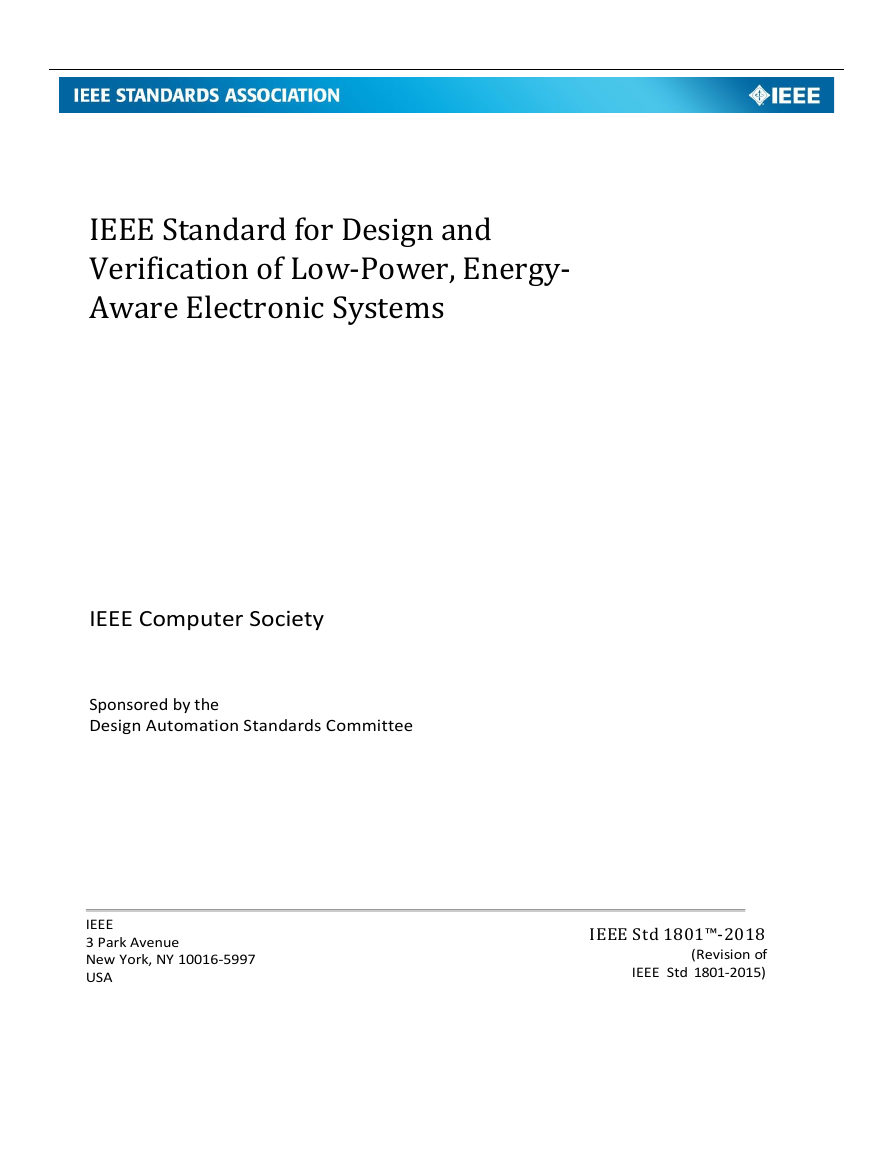
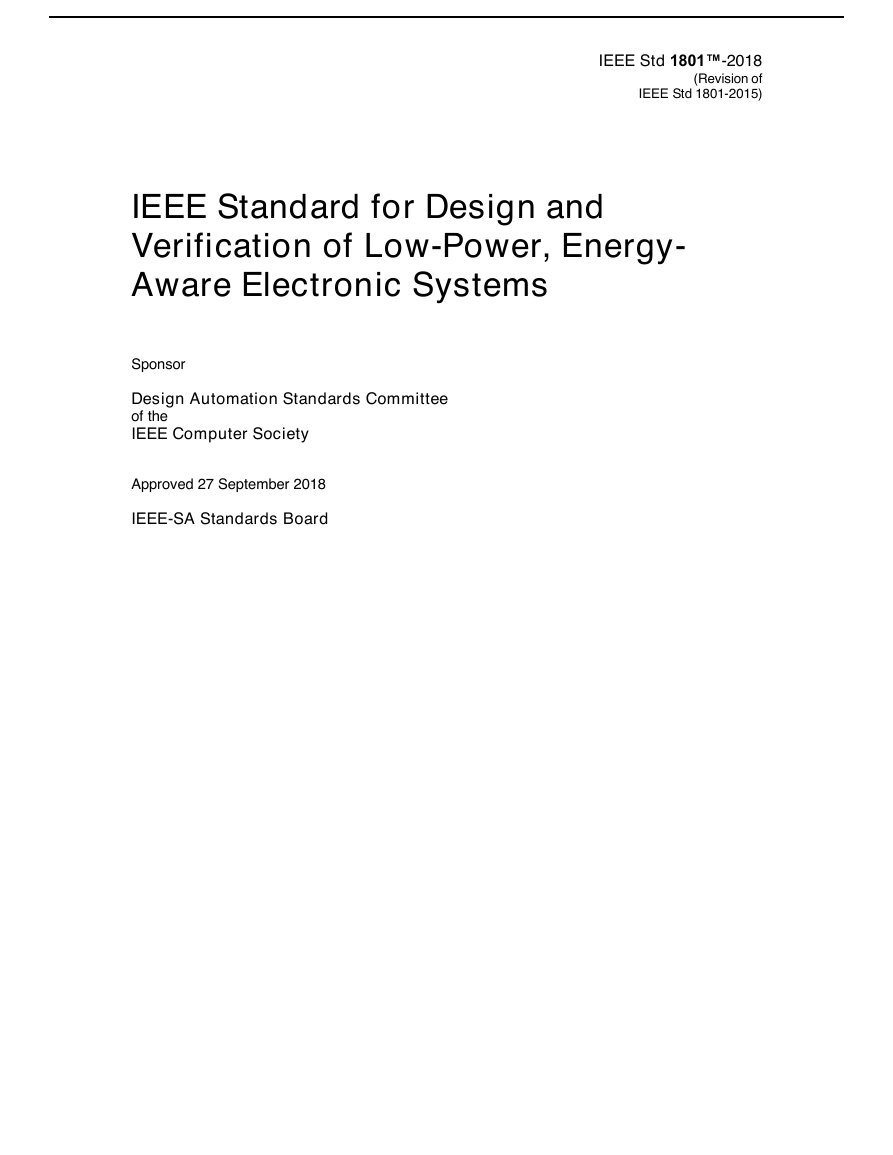
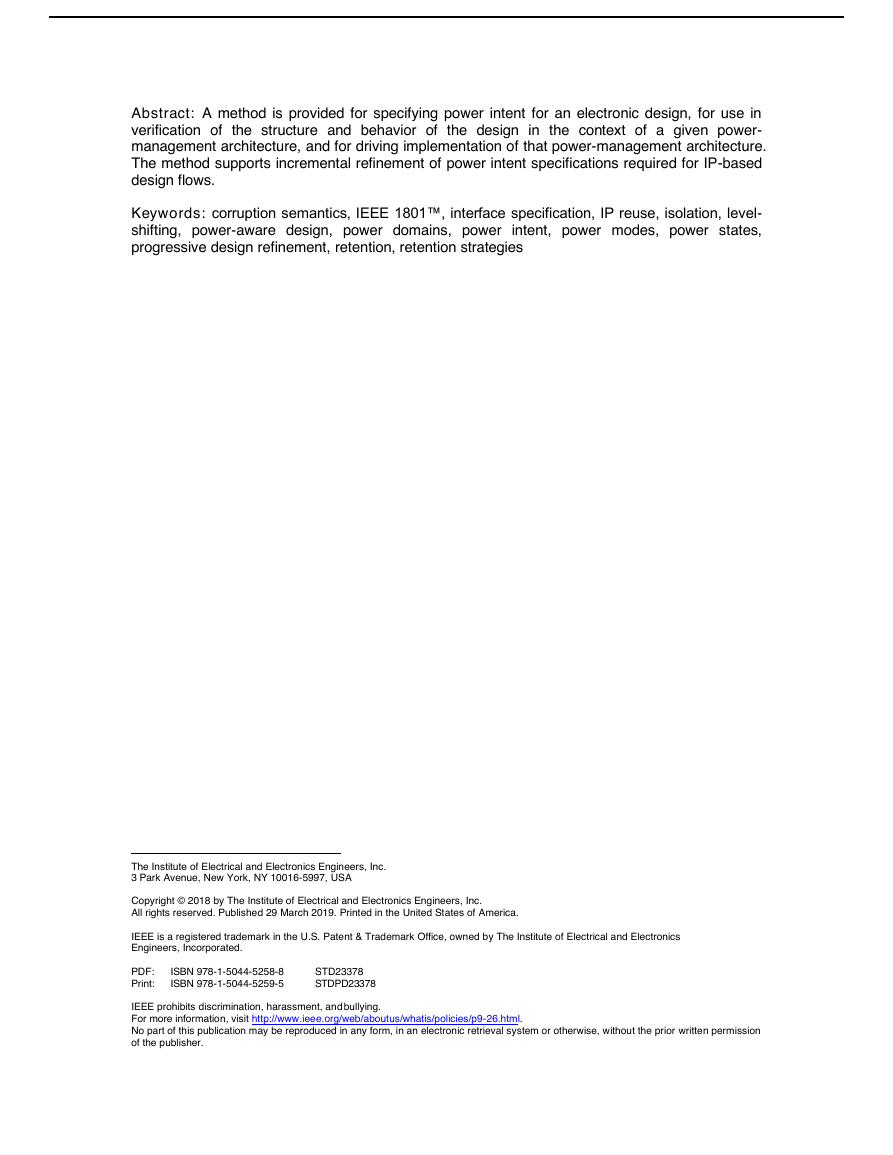
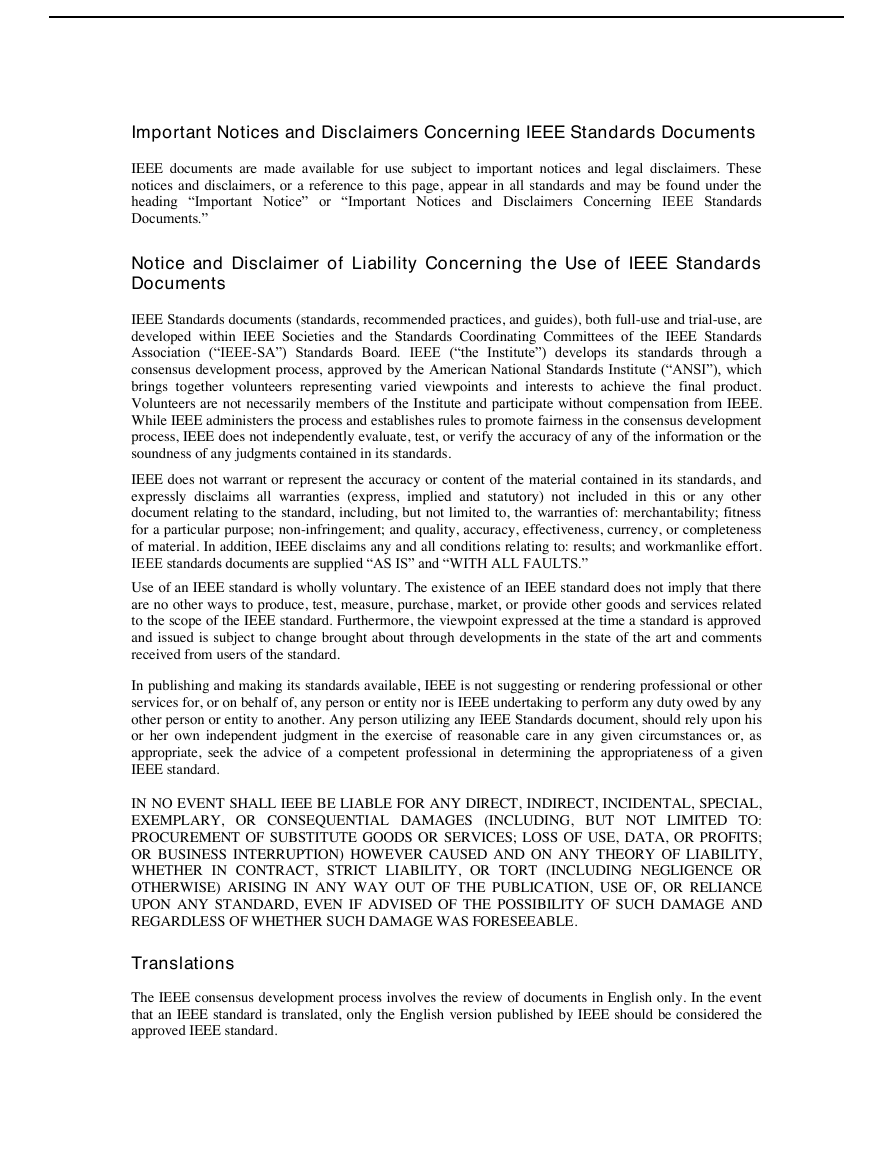

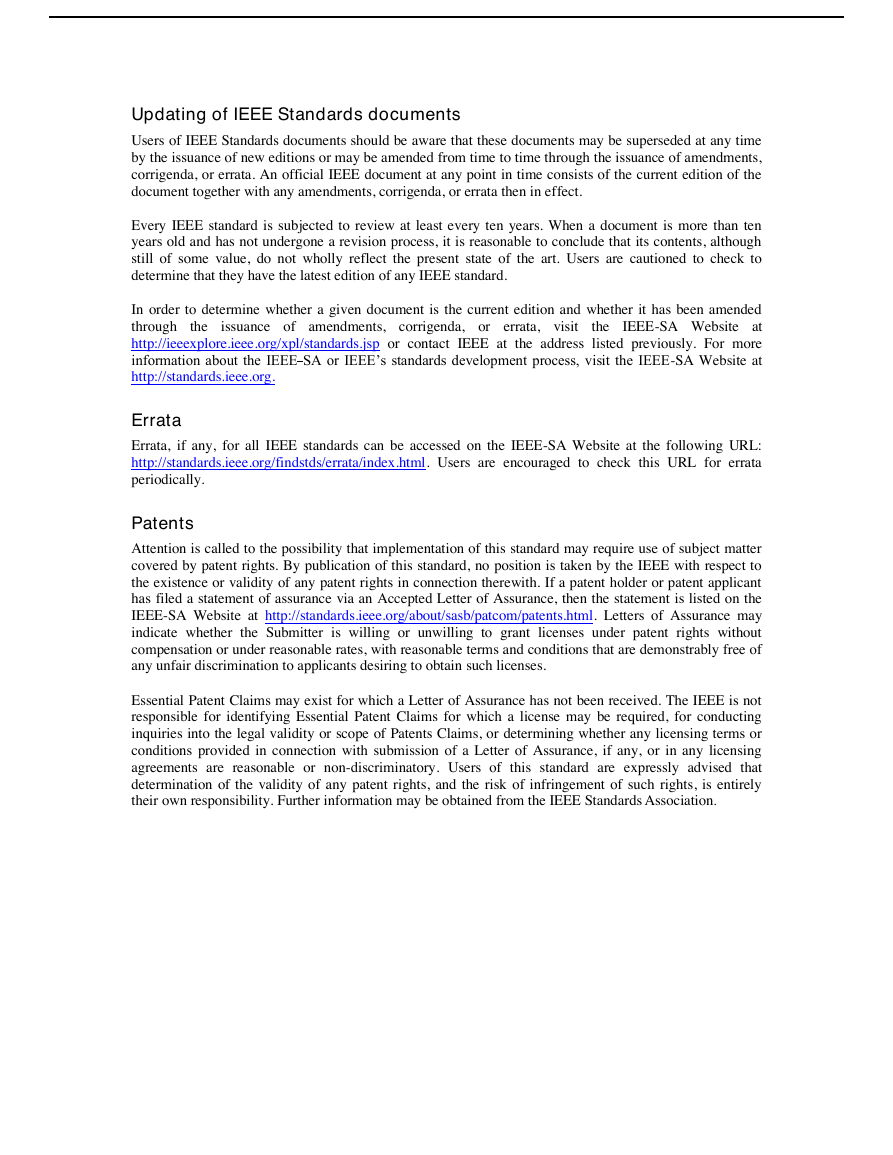
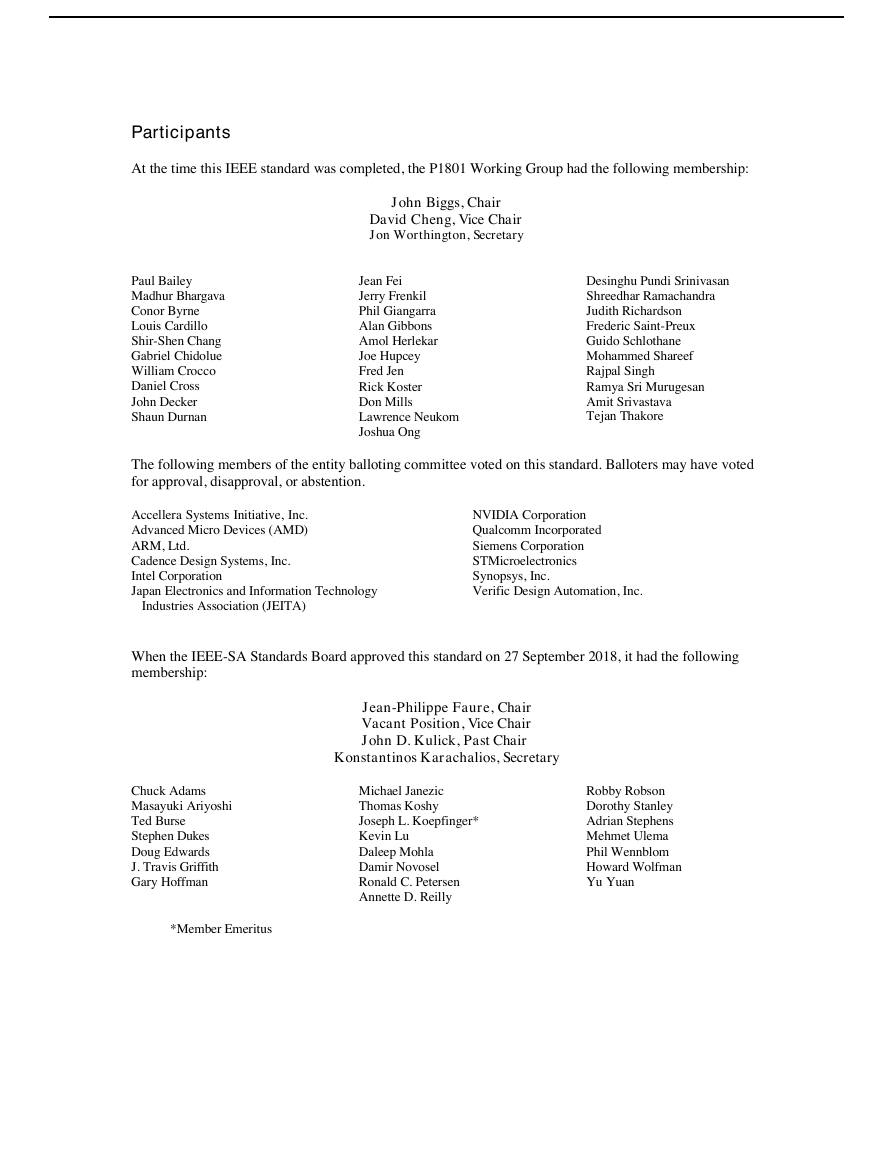
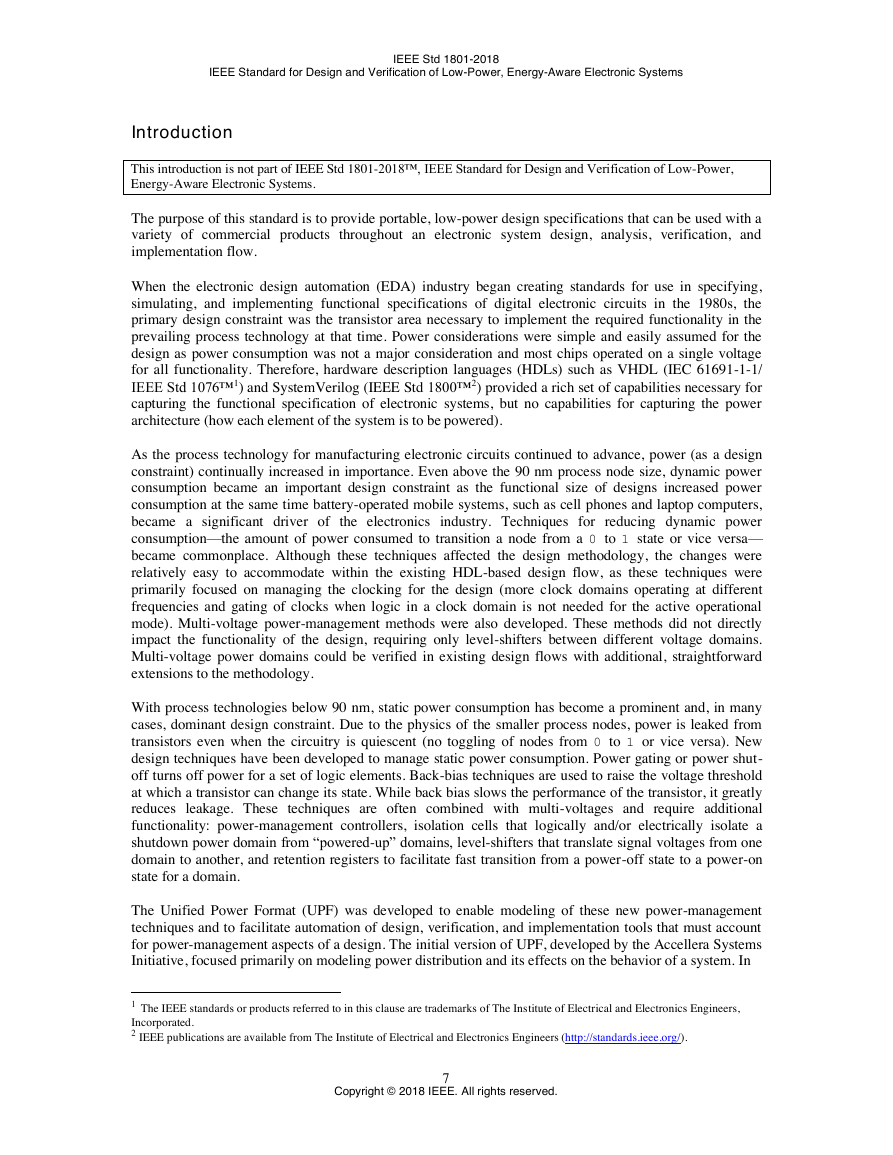








 2023年江西萍乡中考道德与法治真题及答案.doc
2023年江西萍乡中考道德与法治真题及答案.doc 2012年重庆南川中考生物真题及答案.doc
2012年重庆南川中考生物真题及答案.doc 2013年江西师范大学地理学综合及文艺理论基础考研真题.doc
2013年江西师范大学地理学综合及文艺理论基础考研真题.doc 2020年四川甘孜小升初语文真题及答案I卷.doc
2020年四川甘孜小升初语文真题及答案I卷.doc 2020年注册岩土工程师专业基础考试真题及答案.doc
2020年注册岩土工程师专业基础考试真题及答案.doc 2023-2024学年福建省厦门市九年级上学期数学月考试题及答案.doc
2023-2024学年福建省厦门市九年级上学期数学月考试题及答案.doc 2021-2022学年辽宁省沈阳市大东区九年级上学期语文期末试题及答案.doc
2021-2022学年辽宁省沈阳市大东区九年级上学期语文期末试题及答案.doc 2022-2023学年北京东城区初三第一学期物理期末试卷及答案.doc
2022-2023学年北京东城区初三第一学期物理期末试卷及答案.doc 2018上半年江西教师资格初中地理学科知识与教学能力真题及答案.doc
2018上半年江西教师资格初中地理学科知识与教学能力真题及答案.doc 2012年河北国家公务员申论考试真题及答案-省级.doc
2012年河北国家公务员申论考试真题及答案-省级.doc 2020-2021学年江苏省扬州市江都区邵樊片九年级上学期数学第一次质量检测试题及答案.doc
2020-2021学年江苏省扬州市江都区邵樊片九年级上学期数学第一次质量检测试题及答案.doc 2022下半年黑龙江教师资格证中学综合素质真题及答案.doc
2022下半年黑龙江教师资格证中学综合素质真题及答案.doc